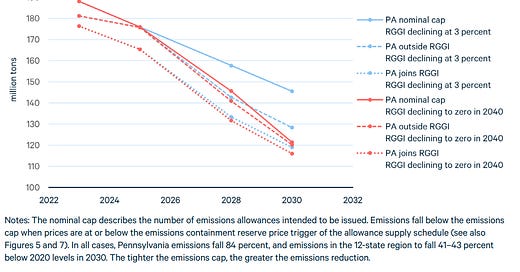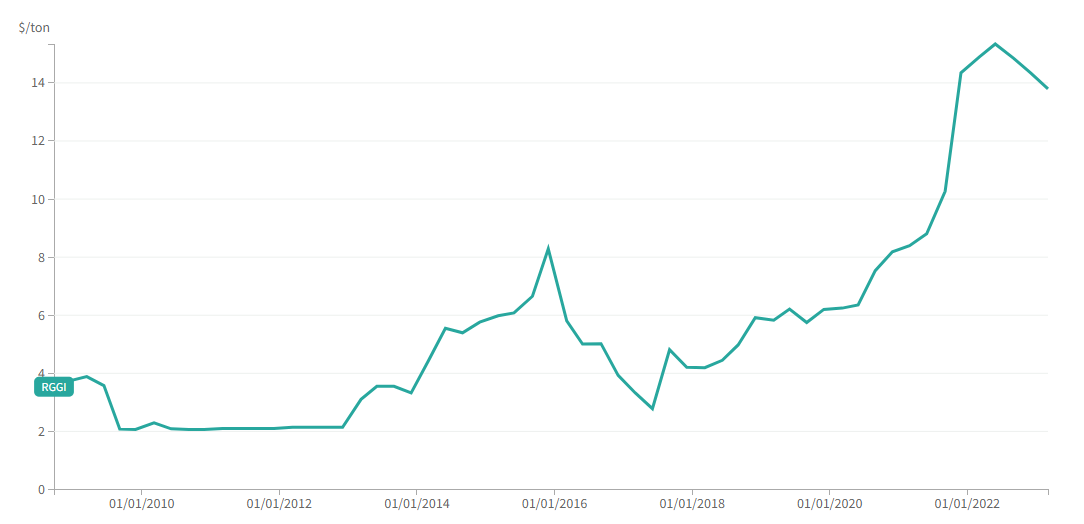Participation game
What Pennsylvania’s participation in RGGI means for emission allowance prices
Pennsylvania’s participation in the Regional Greenhouse Gas Initiative (RGGI) could contribute to an 80%+ decline in the price of emission allowances in the north-eastern US cap-and-trade market between now and 2030, according to recent analysis.
If you are invested in the KraneShares KFA Global Carbon ETF (KRBN), or the Ninepoint Carbon Credit ETF (CBON) then you will have at least some exposure to the RGGI market; the former less than 5%, while the latter accounts for around 25% of assets under management within the fund.
To recap, eleven states from the Northeast and Mid-Atlantic US currently participate in RGGI: Connecticut, Delaware, Maine, Maryland, Massachusetts, New Hampshire, New Jersey (withdrew in 2012, but re-joined in 2020), New York, Rhode Island, Vermont, and Virginia (joined the program at the beginning of 2021).
On 1st July 2022, Pennsylvania became the 12th state to join RGGI. However, one week later the Commonwealth Court of Pennsylvania issued an injunction preventing the state from carrying out its obligations under its membership of RGGI. At the moment the state sits out on the quarterly auctions of RGGI emission allowances.
Legal wrangling has continued for the best part of a year, but a final ruling is expected to be issued soon, potentially paving the way for Pennsylvania to finally participate in RGGI.
The price of RGGI emission allowances has tripled over the past 5 years to around $15 per tonne. The price has been supported by higher emissions as strong natural gas prices increased demand for thermal coal, risk averse compliance entities in Pennsylvania looked to secure allowances ahead of the state’s entry into the scheme, and a decline in the availability of free emission allowances.
RGGI allowance price
The significance of the $15 per tonne level is that it is close to where the Cost Containment Reserve (CCR) trigger price is currently set. The CCR immediately introduces a fixed quantity of additional allowances into each auction if there is sufficient demand above the CCR price (see Everything you need to know about the RGGI carbon market).
Unlike many other mandatory emissions trading schemes, RGGI only covers the power generation sector. RGGI requires fossil fuel power plants with capacity greater than 25 MW to obtain an allowance for each tonne of carbon dioxide they emit annually. RGGI prices are trading for around half of the price of Californian carbon allowances (CCA’s). This is at least partly due to the much wider proportion of the economy that is subject to a carbon price in California. Other sectors such as industry typically require a much higher carbon price than the power sector to incentivise decarbonisation.
Despite improvements over the past 15 years, as thermal coal generation has increasingly been substituted for natural gas, the electricity generation sector remains the second largest emitter in Pennsylvania after industry. As recently as 2019 thermal coal still accounted for over 50% of its power generation emissions. If Pennsylvania does get to participate in RGGI, total emissions covered by the cap-and-trade scheme will increase by almost 70%.
Given that backdrop, how is it that the addition of a large, relatively fossil fuel intensive jurisdiction to the RGGI could have such a big bearish impact on the price of emission allowances?
Keep reading with a 7-day free trial
Subscribe to Carbon Risk to keep reading this post and get 7 days of free access to the full post archives.




